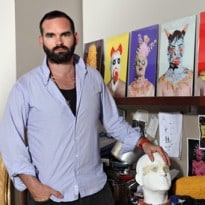James Ostrer's affair with junk food began in earnest after his parents divorced. Every weekend his father would collect the children (he was often late; it was a tense handover) and take them to McDonald's, which Ostrer came to view as "a place of relaxation and fun". Ever since, he says, "when I feel distressed, I will go straight for this kind of food." Which, in a roundabout sort of way, is why he has spent at least £5,000 in the last two years on Mars bars, Jelly Babies, strawberry bootlaces and other sweets and crisps.
This vast stash was not for eating, but to be used in human sculptures through which Ostrer would explore his relationship with junk food, and perhaps even rid himself of his addiction. He and others were caked in cream cheese that had been dyed lurid colours, inlaid with, as Ostrer puts it, "scientifically produced items developed to attract us without any nutritional value".
The photographs in which the artist documented this exercise are by turns grotesque, hilarious and tragic. They are the childhood dream of the gingerbread house - a world spun from sugar - turned nightmare. And appearing, as they are, in the same year in which the notion of sugar addiction has been widely accepted into the public consciousness and been blamed outright for the obesity epidemic, it's hard not to see in them an element of harsh truth.
Some of the caricatures that Ostrer has created, with their bulging gelatin eyes and misshapen heads, have an alien quality. Others use generic tribal imagery in a reference to ancient hunter-gatherers who, he imagines, had to endure multiple bee stings to score some honey. Now, he says, "you just have to stick your hand out and grab a whole pile of things from the checkout. It's not special any more."
There are echoes, too, of Jake and Dinos Chapman's Family Collection, which featured African-style carvings incorporating McDonald's logos and emblems. "Fifty per cent of the time," says Ostrer, "you feel fucking awful about what we do to the world, how we get our T-shirts and food so cheap, and then the other half is: 'Yeah, I'm having a great time, look at me under the blue sky driving a nice car.'"
Along with the black humour, and monstrous quality of many of these sugar zombies, some, with their ornate headdresses and plinths, are intended to reflect the way that the young Ostrer worshipped marketing mascots such as Tony the Tiger. While immersed in this project, he says, "I've had dreams where these caricatures are telling me how I should live. To me they look like ... this sounds a bit harsh, but if someone had poured acid over Tony the Tiger. It's like they're melting."
In Ostrer's short film showing the making of one of the images, slathering people in gloop and chucking sugar sprinkles all over them looks a right laugh, like messy play for big people. But while the process was "intensely fun", it was also therapy for all involved. "I'm the therapist and the client in all my work." There is a ceremonial quality to the process, he says, which is as important as the final image.
The whole thing looks less fun for the sitters, who must wear goggles under their fake eyes, and are temporarily rendered blind, dumb and paralysed, and sometimes have only a single nostril to breathe out of during the photo shoot. "Some people can sit there like a monk for a century," he observes, "and then you ask someone very dynamic and together to stand still for 10 minutes and they'll freak out. That in itself is very interesting for me and them. Emotionally, things come out from people."
One sitter, who works for the secret service in war zones, said after the shoot that he had "never felt so in touch with himself, because when you're covered - your eyes, your ears - you're there in the moment, you feel how you feel, you have to connect with yourself." Ostrer says he felt the same when he did it. "It creates a space of meditation in a way."
Making these images also reminded him of the painful events that ended his painting career. After training at Chelsea College of Art, he spent seven years painting sets at the English National Ballet; then a piece of falling scenery landed on his head and damaged his spinal cord. "I spent months trying to eat my way to happiness," he says, "and actually, all I needed to do was get up and go for a walk." He never picked up a paintbrush again.
Another of Ostrer's sitters asked him to use a type of sweet that she'd once had an extremely negative relationship with. After the shoot she went home and wept for an hour. "Engulfed in the smell of those sweets," Ostrer explains, "she realised how much she'd moved forward."
His own junk-food addiction isn't entirely cured. While handling bin bags full of Wotsits and unwrapping hundreds of Mars bars did create some "emotional detachment" from the products, he says, "you do think: 'Ooh, I really fancy one of those - I'll give it a go.' And then you eat a few and feel sick again, in the same way that everyone does. But I feel like I'm definitely ready to give up now."
• Wotsit all About by James Ostrer is at the Gazelli House Gallery, London W1, until 11 September.








